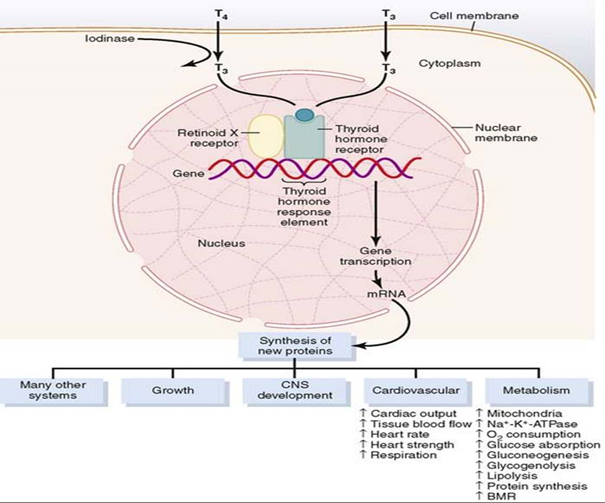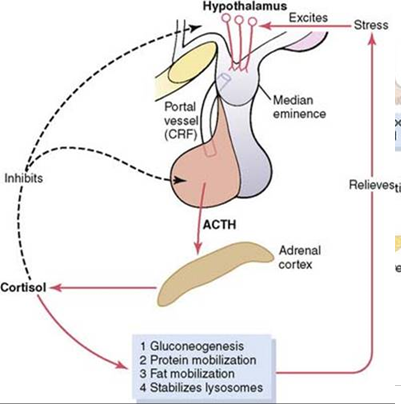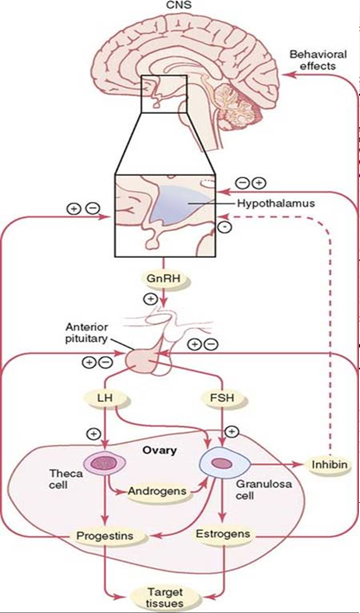This report contains basic neuroanatomy and its organisation in human body. This includes some important regulatory mechanism, actions of some vital hormones and their effect on human physiology and anatomy. By the end of this report, one can understand the basic organisation of human anatomy and how different structures bring about change in human body. Also, role of this basic neuroanatomy with endocrine system and how this together, bring about physiological and anatomical changes in human body.
Structure and function of the brain, spinal cord, peripheral nerves and the autonomic nervous system
The neuron transmits through synapses located mostly on the dendrites of the neuron, but also on the cell body. The efferent signal travels by way of a single axon leaving the neuron ending up as various branches to central or peripheral nervous system.
A characteristic property of most synapses is that they are unidirectional which helps the signal to travel in desired directions. Many of the stimulation of nervous system is by sensory receptor stimulation which transmits sensory information from the receptors of the entire body surface and from some deep structures. This receptor stimulation enters the central nervous system through peripheral nerves and is conducted immediately to multiple sensory levels which includes the spinal cord at all levels, the medulla, pons, and mesencephalon of the brain.
The autonomic nervous system is activated mainly by centres located in the various parts of nervous system which includes spinal cord, brain stem, and hypothalamus and some part of the cerebral cortex, most importantly the limbic cortex. It can send signals to the lower centres and in this way influence autonomic control. The efferent autonomic signals are transmitted through two major subdivisions called the sympathetic nervous system and the parasympathetic nervous system
Role of component of Spinal Reflex Arc:
The pathways for stimulating the spinal reflex do not pass directly to the anterior motor neurons but instead pass first into the spinal cord neurons and only secondarily to the motor neurons. The basic circuits involved are, diverging circuits to spread the reflex to the necessary muscles for withdrawal, secondly, circuits for reciprocal inhibition, and circuits to cause prolong discharge even after the stimulus is over.
PROPAGATION OF A NERVE IMPULSE AND SYNAPTIC TRANSMISSION
In the central nervous system, the information is mainly spread in the form of nerve action potentials. Moreover, each action potential may be blocked in its transmission from one neuron to the next, are the functions can be classified as synaptic functions of neurons. (Ruff, 2003)
Presynaptic terminals lie on the surfaces of the dendrites, are the ends of nerve fibers that originate from many other neurons. These terminal most of the time can excite or inhibit postsynaptic neuron.
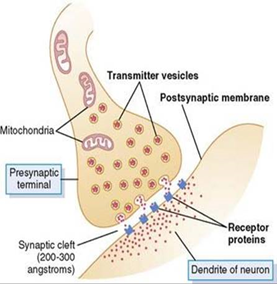
Anatomically, presynaptic membrane which contains large numbers of voltage-gated calcium channels. With the generation of an impulse, action potential depolarizes the presynaptic membrane, these calcium channels open and allow large numbers of calcium ions to flow into the terminal. (Christopher A Reid, 2003)
The postsynaptic neuron contains large numbers of receptor proteins, where the neurotransmitter coming from the presynaptic terminal binds. Postsynaptic receptor, when activated, can be excitatory or inhibitory. The mechanisms used by the different receptors to cause excitation or inhibition include the following.
For Excitation, by far the most important mechanism is opening of sodium channels allow positive electrical charges to flow into the postsynaptic cell. This raises the intracellular membrane potential to more positive direction further decreasing diffusion of negatively charged chloride or potassium ions to the inside or outside of the postsynaptic neuron. This creates more positive internal membrane potential than normal, which is excitatory.
As for inhibition, opening of chloride ion channels through the postsynaptic neuronal membrane, allowing rapid diffusion of negatively charged ions from outside the postsynaptic neuron to the inside, which is inhibitory. Together with increase negative influx, Increase potassium ions out of the neuron, which causes increased negativity inside the neuron.

MAJOR ENDOCRINE GLANDS AND THE HORMONES THEY PRODUCE REGULATE BODY FUNCTIONS THROUGH THEIR INTERACTION WITH TARGET TISSUES:
Two main important structure carries utmost integrity to govern several functions of the body. One is pituitary gland and other is pancreas.
Physiologically, the pituitary gland is divided into two the adenohypophysis, and the neurohypophysis. Six important hormones are secreted by the adenohypophysis, and two important hormones are secreted by the neurohypophysis. The following figure summarizes the effect of some hormones
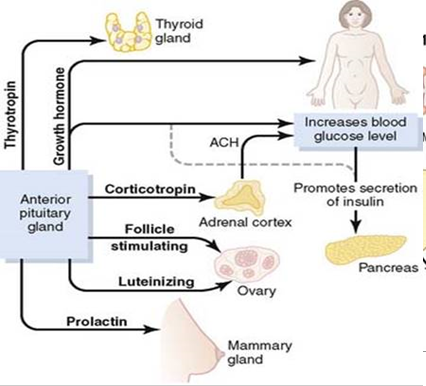
Growth hormone enhances the growth of the entire body by encouraging protein synthesis by cells, while at the same time turn down the breakdown of proteins. The result of growth hormone on carbohydrate metabolism includes reduce glucose uptake in tissues, promotes glucose production by the liver, and upregulate insulin secretion
Adrenocorticotropic Hormones:
The best known metabolic effect of cortisol is gluconeogenesis by the liver. Other function includes:
Cortisol stabilizes the lysosomal membranes. It has anti-inflammatory effects, and decreases the release of proinflammatory mediators. Cortisol also foster mobilization of fatty acids from adipose tissue, increasing the concentration of free fatty acids in the plasma.
Aldosterone promotes reabsorption of sodium and increases secretion of potassium in the principal cells of the collecting tubules. As a result, aldosterone causes sodium to be retained in the extracellular fluid while increasing potassium wasting in the urine.
(hall, 2016)
Thyroid hormone produce various intracellular effects as shown in the diagram below. The prime effects cause by thyroid include increase metabolism of carbohydrate and fats. Also it help in synthesis of proteins and maturation of cells. (Yen, 2001)
(hall, 2016)
Prolactin is secreted by anterior pituitary gland, with progressive rise in quantity during pregnancy. Prolactin increase the release of milk.
Both FSH and LH enhances highly specific FSH and LH receptors in the ovarian target cell membranes. This then, increase the cell growth and proliferation of the cells. These stimulatory effects result from activation of the cyclic adenosine monophosphate second messenger (T M Plant, 2001)
The prime mechanism by which ADH acts on the collecting ducts to increase their permeability to water. ADH acts on the cell, phosphorylation special vesicles, which when inserted on the apical cell membranes, provides areas of high water permeability.
Prolactin from anterior pituitary increase progressively during pregnancy. Moreover, it has important role in Lactation. It presents milk from alveoli into the ducts of the breast so that the baby can obtain it by suckling.
The pancreas produces two hormones, insulin and glucagon. Pancreas contains islets of Langerhans, which produce insulin and glucagon into the blood.
Insulin promotes muscle glucose absorption and metabolism. After a meal, blood glucose concentration is high and the pancreas is secreting large quantities of insulin. The additional insulin induces prompt transport of glucose into the muscle cells.
Secondly, insulin cause most of the glucose absorbed after a meal to be stored in the liver in the form of glycogen. Insulin enhances the conversion of excess glucose into fatty acids. Insulin also promotes protein and fatty acid synthesis. (Andreas Barthel 1, Dieter Schmoll, 2003)
The most important outcome of glucagon on glucose metabolism includes, breakdown of liver glycogen and increased gluconeogenesis collectively increasing the blood glucose level
Regulation of endocrine glands:
Negative feedback prevents over activity of hormone systems, ensuring proper level of hormone activity at the target tissue. After the release of hormone, the outcome of the action of the hormone prevents further release.
ROLE OF NERVOUS AND ENDOCRINE SYSTEM IN:
TEMPERATURE REGULATION:
Temperature regulation is interlinked with endocrine and nervous system. The primary centre of temperature regulation is in hypothalamus. Increase in body temperature brings vasodilation of skin blood vessels. Vasodilation can increase the rate of heat transfer to the skin as much as eightfold. Sweating, increase in the rate of evaporative heat loss and hence lowering of temperature. Aldosterone has vital role in conserving salts during excessive sweating by conserving sodium and water.
Decrease in heat production further decrease the body temperature to optimum level
Decrease in body temperature stimulate vasoconstriction and increase heat production to maintain body temperature.
STRESS RESPONSE:
The sympathetic system in stress activates hypothalamus, from where signals are transmitted downward through the reticular formation of the brain stem and into the spinal cord to cause massive sympathetic discharge. It is also called the fight or flight reaction. In response to this sympathetic surge, human body is prepared for a fight or to run from that situation.
BLOOD SUGAR CONTROL:
In blood sugar regulation, both nervous system and endocrine system plays an integral role in maintaining blood sugar within normal range. As in hyperglycemia, increase blood glucose level in turn stimulates insulin from pancreas which decrease the blood sugar levels. On the opposite, hypoglycemia induces increase production of glycogen which increase blood sugars to normal levels.
Conclusion
Finally, through this report one can identify the basic structure of neuroanatomy and role of various structures in establishing nerve conduction. The structural importance and stimulation of autonomic nervous system and its role in regulating various involuntary function of organs, carries a vital part in hemodynamic stability. The emphasis on mechanism of synaptic transmission provides adequate information and its relevance with unidirectional nerve transmission. The structural ability of synapsis to stimulate nerve endings and produce neurotransmitters, which can either stimulate or inhibit, to produce various effect.
Moreover, the role of endocrine system plays a pivotal role in maintain hemodynamic stability. The role of various hormone is to maintain normal physiological parameters for organs to work efficiently.
Lastly, the interconnection between endocrine and nervous system to regulate different function, is the key mechanism for hemodynamic stability. The mechanism to tight control with negative feedback mechanism, the stimulation of various responses in certain condition, counter reacting to hemodynamic stability, all are due to tight regulatory system between endocrine and nervous system.
Recommendations
Aforementioned conclusion, one can clearly identify the role of nervous and endocrine system in regulation of various functions in the body. In my opinion, both the endocrine and nervous system together when interlinked produce physiological outcome beneficial.
Peachy Essay and its solid medical science writing help team consist of several medical doctors provides a wide range of academic writing services including:
– Medical science assignment help
– Medical science essay help
– Medical science dissertation help





